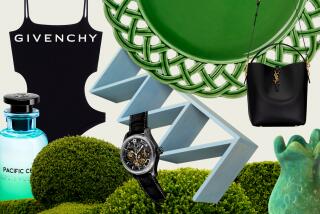Spring Consensus About Shoes: Flats Are Sharp
Spring ’86 may be the season the humble flat shoe gains some fetishists of its own.
Traditionally the dull sister of the sexy spike heel, this sensible schoolmarm of footwear has finally outgrown its plain pallor.
American designers, such as Perry Ellis, Calvin Klein, Anne Klein and Ralph Lauren, broached the idea in recent seasons by showing flats with their runway fashions and by featuring them as a large part of their shoe collections. The flat has since become a major look of spring designer lines and a major spring investment for stores.
“It seems more natural and more modern, especially for the professional woman, to wear flats during the day,” says Calvin Klein, whose spring flats include open-toe sling backs and lace-up sandals.
“The flat can change the proportion of the clothes, but any outfit can be worn with flats,” he says. The new flats are being paired with tailored suits, day dresses, evening pajamas, anything ‘60s-chic and as a general alternative to the high-heel pump.
“Wearing flats with the sleeker, feminine silhouette is something we hadn’t seen until now,” says Patti Lewis, fashion director of Nordstrom.
If the eye is adjusting to new roles for flats, it’s because the flats themselves are changing. “So often flats look like men’s shoes, but I felt this year there was so much pretty detailing--silver studs and soft, glove leathers--instead of the thicker leathers,” says Tom Voltin, women’s footwear manager at Saks Fifth Avenue. Cole Haan and Anne Klein are basics of the flats collection at Saks, Voltin says.
Among spring’s most sophisticated flats are the skimmer--a simple, low-vamp flat with a narrow wedge of a heel. It’s a shoe with “toe cleavage,” as they say in the industry. The two-tone spectator flat--from such designers as Perry Ellis and Ralph Lauren--also is making a nostalgic comeback.
These shapes have been around--but not necessarily in the exotic skins of the moment. Crocodile, snakeskin, alligator and soft leathers appear separately or in patchworks. Other fancy surfaces--metallics, peau de soie and needlepoint--turn even a ballet slipper into something dressy.
Bright colors also coax the eye ground-ward, as do the veritable murals some manufacturers call footwear. Miami-based Paradox by Zalo, for example, paints flats with scenes of fruit, flowers, serpents (and traffic jams and umbrellas for fall)--erasing any thought of the shoe as an inconspicuous neutral.
“When you buy a shoe with a strawberry on the toe, you’re asking people to look at your feet,” says Saks’ Voltin, who considers this a fashion season based on accessories.
Fashion pundits insist there are no rules for wearing the new flats. But for those who prefer a little structure, Neiman-Marcus Vice President Daria Retian advises that as heels drop, hemlines should rise.
Likewise, the question of color--whether to blend or contrast--brings little hand-holding from the experts. Retian suggests wearing a bright flat as a one-time accent or as part of a recurring color theme. For a conventional “together” look, repeat the shoe color at least once in clothing, scarf, belt or purse.
The crush of colored and patterned hosiery further complicates the formula. A few guidelines: To elongate the body, match dress to hose and shoe color. To draw the eye to the foot, wear a contrasting shoe. To bring the eye to the leg, choose a contrasting stocking. Daring souls may try three different colors for hose, shoes and skirt.
“The eye is attracted to wherever you create a break in color,” says Patricia Fox, Saks’ director of fashion and publicity. “They’re all correct. It’s just a matter of choice. But the more colors, the more avant-garde you’re making the look.”
Visual Dilemmas
Regardless of the visual dilemmas posed by the new flats, at least they don’t murder the foot. Habitually wearing high heels not only shortens the calf muscle (don’t tell us), but it pitches the weight forward, creating an unnatural weight distribution across the forefoot, or metatarsal bones, says Dr. Jon Hultman, UCLA assistant professor and podiatrist.
Hultman notes that if vanity brings consumers back to the flats, feet are probably better off--especially for walking at length. But he adds: “I know I’m not going to get away from the fashion aspect with patients.”






